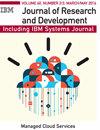Deep learning acceleration based on in-memory computing
IF 1.3
4区 计算机科学
Q1 Computer Science
引用次数: 18
Abstract
Performing computations on conventional von Neumann computing systems results in a significant amount of data being moved back and forth between the physically separated memory and processing units. This costs time and energy, and constitutes an inherent performance bottleneck. In-memory computing is a novel non-von Neumann approach, where certain computational tasks are performed in the memory itself. This is enabled by the physical attributes and state dynamics of memory devices, in particular, resistance-based nonvolatile memory technology. Several computational tasks such as logical operations, arithmetic operations, and even certain machine learning tasks can be implemented in such a computational memory unit. In this article, we first introduce the general notion of in-memory computing and then focus on mixed-precision deep learning training with in-memory computing. The efficacy of this new approach will be demonstrated by training the MNIST multilayer perceptron network achieving high accuracy. Moreover, we show how the precision of in-memory computing can be further improved through architectural and device-level innovations. Finally, we present system aspects, such as high-level system architecture, including core-to-core interconnect technologies, and high-level ideas and concepts of the software stack在传统的冯·诺伊曼计算系统上执行计算会导致大量数据在物理上分离的存储器和处理单元之间来回移动。这会耗费时间和精力,并构成固有的性能瓶颈。内存计算是一种新颖的非冯·诺伊曼方法,其中某些计算任务在内存本身执行。这是通过存储设备的物理属性和状态动态实现的,特别是基于电阻的非易失性存储技术。一些计算任务,如逻辑运算、算术运算,甚至某些机器学习任务,都可以在这样一个计算存储单元中实现。在本文中,我们首先介绍了内存计算的一般概念,然后重点介绍了使用内存计算的混合精度深度学习训练。这种新方法的有效性将通过训练MNIST多层感知器网络来证明。此外,我们还展示了如何通过架构和设备级创新进一步提高内存计算的精度。最后,我们介绍了系统方面,例如高级系统架构,包括核心到核心互连技术,以及软件堆栈的高级思想和概念。
本文章由计算机程序翻译,如有差异,请以英文原文为准。
求助全文
约1分钟内获得全文
求助全文
来源期刊

IBM Journal of Research and Development
工程技术-计算机:硬件
自引率
0.00%
发文量
0
审稿时长
6-12 weeks
期刊介绍:
The IBM Journal of Research and Development is a peer-reviewed technical journal, published bimonthly, which features the work of authors in the science, technology and engineering of information systems. Papers are written for the worldwide scientific research and development community and knowledgeable professionals.
Submitted papers are welcome from the IBM technical community and from non-IBM authors on topics relevant to the scientific and technical content of the Journal.
 求助内容:
求助内容: 应助结果提醒方式:
应助结果提醒方式:


